1849: When the Pioneers Crossed the Jordan River
Over Jordan: The Beginnings of a New Settlement
In 1849, a small band of pioneers crossed the Jordan River and began carving out a new world for farming—by hand, by faith, and through trial and error. Fields were planted along the riverbanks, water was diverted for irrigation, and rough levees were built to guide the flow. Fences were fashioned from stakes cut from nearby trees. This was the birth of Harker’s Settlement, the first organized community on the west side of the Jordan River.
By January of that year, Joseph Harker and his family had crossed at about 3300 South, on land later owned by Bishop Daniel McRae. They were soon joined by Samuel and John Bennion, Thomas Mackay, Thomas Tarbet, William Blackhurst, William Farrer, and John Robinson. The area quickly became known simply as “Over Jordan.”
In those early months, the settlers lived in wagons and tents, and some took shelter in dugouts carved into the steep riverbanks until cabins could be built. Their challenges were immense—skirmishes with Native tribes, hunts for wild game, failed irrigation ditches, and the devastation of crops. A few potatoes were dug and a little corn ripened, but most of the wheat was destroyed by crickets. The meager stalks that survived had to be pulled by hand.
When their efforts proved unsustainable, the settlers moved again—this time farther south to a bend of the Jordan River where Big Cottonwood Creek flowed in, an area they called Fisher’s Bottom. Drawing water from Bingham Creek, they managed a small joint crop, but the task of taming the desert proved too great for so few families.
By 1849 and into the early 1850s, others joined them: Robert Pixton and Jacob Butterfield (both veterans of the Mormon Battalion), Archibald Frame, John Webster, Llewellyn Mantle, William Haigh, Abram Todd, Alfonso Morris, William Parker, Homer Brown, Samuel Bringhurst, Mr. Bockholt, Burr Frost, Charles Player, and George Moses.
Later, Pixton explained his move from Salt Lake City:
“Salt Lake City has become too large and dangerous to raise a family in.”
Even so, not all who came stayed. A number of newly arrived Welsh settlers soon grew discouraged, moving again in search of better water and land.
By 1850, the group relocated once more—still following the Jordan’s winding course—finally settling at the site that would become Taylorsville. Here, each family claimed land and began to build what they hoped would be lasting homes. Joseph Harker’s property lay between Samuel and John Bennion, while others took up adjoining tracts, forming a close-knit, cooperative community bound by faith and necessity.
Life remained harsh and uncertain. The settlers faced Indian raids, water shortages, and long winters. They planted gardens from cherished seeds and fruit pits brought from England. Food was scarce—thistle roots, sego lilies, milk, and a little flour often sustained entire families. Flax was grown for linen, and buckskin, traded from local tribes, was crafted into durable clothing.
Yet their perseverance endured. While the men built homes, herded cattle, and moved joint herds to Rush Valley for grazing, the women spun yarn, knitted mittens and socks, molded candles, and tended gardens. Through their collective labor and faith, they transformed hardship into stability and wilderness into community.
From those first dugouts on the riverbank came something lasting—a settlement born of courage, unity, and endurance. Their efforts laid the foundation for the thriving towns that followed—Taylorsville, Bennion, and Granger—all descendants of those who first dared to cross “Over Jordan.”

